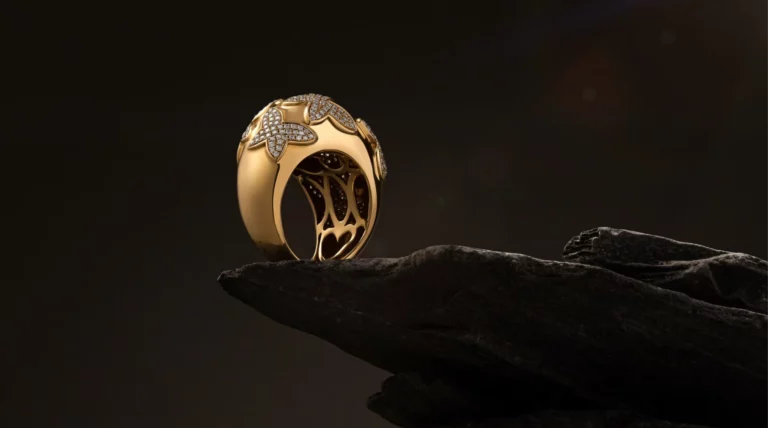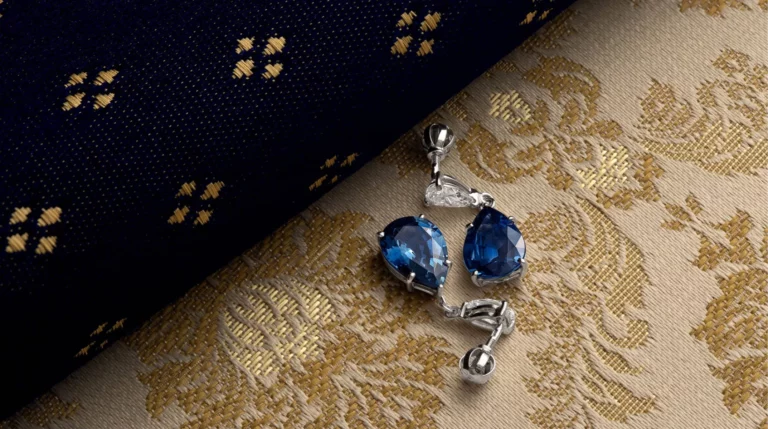Want to learn about jewelry photography product styling and props? and how to effectively use them in order to make your images look like this? Don’t worry, we’ve got you covered. Truth be told, with established brands spending big bucks on their imagery, keeping up with them requires both creativity and product photography knowledge.
Fortunately, this article will help you do just that. Jewelry product photography styling is an art that requires a lot of attention to detail. You need to capture the beauty and complexity of jewelry in a way that appeals to potential customers. An important aspect of jewelry photography is product styling and props, which can make or break your images, and today, you’ll learn all about them.
Jewelry photography product styling tips

How should you effectively style your jewelry? In reality, the vast sea of styles can be quite overwhelming, even for experienced photographers. This is why we’ve prepared for you a simplified list of points you need to perfect to get your own brand’s style in front of your customers. Let’s begin!
Textured backgrounds
In order to make your jewelry stand out from the flood of available options, consider adding textured backgrounds to your jewelry photos. Basically, textured backgrounds serve as props used in photography to create depth and interest in the image.
One way to add jewelry textured backgrounds is to use natural elements like wood, stone, or plants. These elements add a rustic or earthy feel to your jewelry while adding depth to the image. Artificial props like fabrics or paper with intricate patterns can also enhance the overall aesthetic of your photos. All in all, it’s your style you’re after, so experiment as much as you can and bring your brand’s vision, values, and look to light.
Jewelry Photography Lighting techniques

Proper lighting can bring out the sparkle and shine of your jewelry while highlighting its unique features. A battle-proven lighting technique for jewelry photography is to use natural light. This means taking your photos in daylight and placing your subject near a window or outdoors where there is plenty of natural light.
Direct sunlight can cause harsh shadows, so it’s best to use diffused light by placing a white sheet or sheer curtain in front of the window to soften the light. You can also try shooting on a cloudy day when the clouds act as a natural diffuser, but we always recommend waiting for the golden hour.
Another effective lighting technique for jewelry photography is to use artificial lights, such as a light box or ring lights. These lights provide even lighting and are ideal for achieving even illumination of your subject.
Using contrast to your advantage

Contrast in photography refers to the difference between light and dark areas in a photograph. By manipulating contrast, you can create a more dynamic and visually appealing image.
The first step to using contrast in jewelry photography is to understand the lighting conditions. As mentioned earlier, natural light is best for shooting jewelry because it brings out the sparkle and shine of each piece of jewelry. When positioning your lighting, play with different angles until you find one that brings out the contrasts and shadows of your subject.
Another way to use contrast in jewelry photography is to choose a contrasting background color or prop that complements your piece of jewelry. Since most jewelry has bright colors, you can experiment with dark and moody shades to make your product stand out in the image.
Props you should definitely include
Now that you have some styling basics to bring out your ideas to reality, let’s take a look at some props for jewelry photography!
Hook backs for earrings

A popular prop for earrings is the hook back. This type of earring holder is perfect for adding dimension and interest to your jewelry photos. First, pick a pair of earrings with unique details or textures to use the hooks as props. Thereafter, place the earrings on a flat surface and tilt them slightly toward the camera to create depth. You can also hang them from a string or thread to create the illusion of movement.
Prop wax for maximum stability
As stunning as a jewelry photo shoot can be, it can also be a source of frustration if your jewelry doesn’t stay in place during the shoot. This is where prop wax comes into play. It’s a simple and effective solution to keep your props stable during the photo shoot.
To use prop wax, you first need to choose the right type of wax for your needs. There are several types of prop wax available on the market, each with a different tackiness. For jewelry photography, you should select a wax that is strong enough to hold your props in place, but not so sticky that it leaves residue on your jewelry. A good choice is beeswax-based prop wax because it’s natural and easy to work with.
Seasonal props for authenticity
You can easily make your jewelry look authentic by using seasonal props to complement the photos and add depth. Suitable props for jewelry photography include natural elements like flowers and leaves, as well as Christmas decorations like ornaments or pumpkins.
When choosing seasonal props for your jewelry photography, it’s important to consider the color scheme and theme of your jewelry pieces. For example, if you’re photographing a fall collection with warm gold and bronze tones, autumnal props like colorful leaves or rustic wood accents would enhance the overall esthetic. Similarly, if you’re showcasing summer beach jewelry with bright blues and greens, add shells or coral for a stunning look.
Using seasonal props in jewelry photography can also help tell a story about the pieces presented. As with any other type of prop, its main purpose is to add depth and beauty and tell a story. Describing your brand through props takes a lot of time and effort, and you can start by doing some research about your audience and the values you want to convey to them.
Conclusion
Props play a crucial role in jewelry photography when it comes to enhancing the visual appeal of a product. They are an effective way to convey the brand’s message and personality. The right use of props can enhance the overall aesthetic of your jewelry and create an emotional connection with the target audience.
If you’re having a hard time trying different props and wasting your money on stuff that simply doesn’t work, try CGI. With nothing more than a computer screen and some easy-to-shoot reference images, you can shape reality in your own, personal way. Give this revolutionary alternative to product photography a try and save both time and money on your jewelry photography projects.
FAQ
Why is product styling important in jewelry photography?
Product styling plays a crucial role in jewelry photography, as it helps to enhance the overall presentation and visual appeal of the jewelry. Through thoughtful styling, the photographer can create a context and mood that complements the design and aesthetics of the jewelry.
How do props help in conveying the brand message or story in jewelry photography?
By carefully selecting and incorporating props that are consistent with the brand’s identity, values, or story, photographers can create a cohesive and meaningful composition. For example, if a jewelry brand favors a nature-inspired design, using natural elements such as leaves, flowers, or stones as props can reinforce that connection.
What are some popular props commonly used in jewelry photography?
The choice of props in jewelry photography depends on various factors such as the brand’s style, the specific piece of jewelry, and the desired aesthetic. Some popular props often used include hook backs for earrings, prop wax, and plenty of seasonal props for authenticity.


























